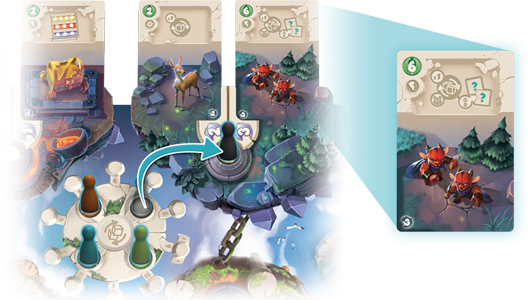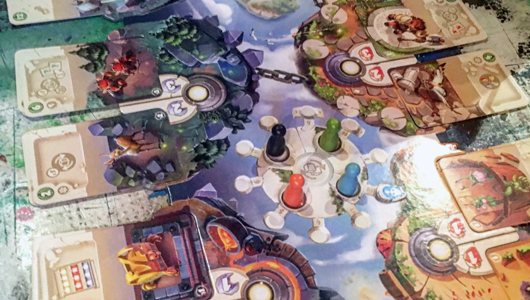Sometimes you don’t need to reinvent the wheel. If existing principles and mechanics have proven to work, then using them well can be still fun and exciting. Sometimes the presentation and the look will go a long way to turn something simple into something special.
Dice Forge did not revolutionise any board gaming conventions. At the core, this is a Eurogame, with its gameplay feeling very familiar. It is also a dice building game, a concept that is, once again, not new. There are plenty of deck building card games out there, and while there are fewer dice building games, the core mechanic are the same. The idea of applying changes directly to your game tool, whether card or dice, has also been done before, just take a look at Mystic Vale. So Dice Forge in a lot of ways feels and plays like games you have seen before. However, it does it exceptionally well.
• Designer: Régis Bonnessée
• Publisher: Asmodee
• Number of Players: 2-4
• Playing Time: 40 mins

In Dice Forge, players roll die to gain resources, gold or victory points, that can be either used to upgrade the die faces or to purchase cards with victory points and special abilities. The player with the most points at the end of the game wins. This game is that simple. Yet, it is this simple mechanic that allows so much space for a variety of strategies and approaches, that it immediately elevates the game.

Every player starts with two die with predetermined faces, which levels the playing field, however afterwards there is a large pool of available dice faces that can be customised at will. Using a simple dice frame with clip-on faces is one of the biggest selling points of the game. There is just something so satisfying taking off the standard low-level dice side to replacing it with a better tile, and hope that on the next turn you will roll that new bright and shiny upgraded side. You are also making the dice your own. Every roll has a possibility of surprise where the purchase has paid off, and its benefits can be spent lucratively within the game. In essence, you are creating your own little engine built into the die rolls, that can boost your strategy. While, there is still an element of luck, especially at the beginning of the game, soon the player becomes in charge of their own luck. As you are the builder of your dice, you are also influencing the outcomes.
There are a variety of routes to take when constructing your die, whether to maximise your gold, resources or victory points. There are even dice faces that allow you the choice of either picking gold, resources or victory points, which allows flexibility in your choices going forward.
The cards, that can be purchased using resources, also come with their own set of abilities, continuous or one-use. Most of the abilities maximise your resources or give additional die rolls, however, occasionally there are abilities that can put your opponents at a disadvantage. However, you can play the whole game without using any sorts of attacks. The only real player confrontation happens on the game board. There are dedicated spaces on the board where specific cards can be bought. In the player is already occupying a space, where you want to make a purchase, you bump them back to the centre of the board and they can gain an extra re-roll for being moved.

Otherwise, there is little to no interaction between the players, however, Dice Forge compensates for it in other ways. Only the active player can spend their turn upgrading die or buying cards, but all players roll die each turn. So, even if you are not an active player, there is always something to do. In fact, knowing ahead of time what resources you have available before you become an active player, can help to decide on a strategy for that turn.
Dice Forge is also a fairly quick game. Nine turns, even with the full group of four players, do not last very long. The key, however, is to use your turns efficiently and carefully consider the exact things you need. The limitation of turns, stops player mindlessly rolling a die and building up piles of resources without a clear plan. And, a card that gives you an extra re-roll in the restricted time context becomes that much more powerful.

It is surprising that Dice Forge has a theme that is mostly forgettable and is even a nuisance, as it permeates the rules complicating extremely simple explanations. Bless the designers, they really tried to tie something with ‘forging of dice’ idea, which is a hard thing to do. I honestly cannot recall what the theme is about even after playing the game numerous times, and it does not matter. Enjoy the artwork and roll the die.
This is a very solid game, that is fun, engaging and strategic, however, it also does not do anything spectacularly different, new or exciting to get the full marks. However, what tips it over the point, and makes it a 5 barrel games instead of 4, is the presentation. Dice Forge understands that board gamers love games, interesting mechanics and fun gameplay, but that they also find joy in the physical presentation of the game itself. We sleeve our cards to protect them, buy specially designed boxes, where we can diligently arrange game pieces in their designated spaces, we can spend hours sorting through decks and die, carefully storing and arranging them. All of it is also part of the board game experience that we enjoy, and Dice Forge understands that.

The game components look gorgeous. I already spoke about the clip-on die sides, but there are also cards with gorgeous artwork and resource tiles with colourful markers that fit into the cut-outs provided in the box. The game provides tokens for every occasion, and every component is designed specifically to fit one another. The game board not only has cut-outs to signify where the cards are supposed to go, but the art on the board matches exactly the art on the cards. There is a special tray where all extra die sides are stored that can be sleeved and stored without any of pieces ever spilling into the box.
Last, but not least, is, of course, the box itself. Dice Forge has so many small fiddly components that it could have easily become a setup and packing nightmare. Every game could have been an ordeal to arrange. However, the box is beautifully designed so that every piece, no matter how little, has its own place. Even cards can be pre-sorted and stored in a way, that you never need to sort through them ever again. The only time you really need to set up the game, if the first time you open it, which takes a fair bit of time. However, once it’s done once, the game only takes seconds to set up.

Moreover, the game rules also has instructions for the box, showing locations of all pieces and explaining how they need to be arranged for maximum efficiency. Of course, everything within the box stacks and fits perfectly.
This might seem like a silly thing to rejoice in, but I own so many board gamers where designers have not given a second thought to how their games are stored. On occasion, that even discouraged me from playing those games. I love Blood Bowl Team Manager The Card Game to bits, but every time I want to play that game and remember that I need to sort through those cards, I shudder in horror. Dice Forge’s exceptional presentation that shows respect both for the game itself and the players, is what takes it beyond what you would normally expect.
Dice Forge has simple mechanics that nonetheless allows for complex and competitive gameplay, yet you don’t need to be a hardcore board gamer to be able to play it well. Building your dice, literally, is really fun and satisfying, and the artwork and other game components add that special something to this very straightforward game. It is not a perfect or a particularly original game, but it is done so very well. For me, this is a must buy.






